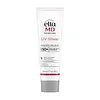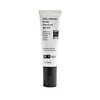What's inside
What's inside
 Key Ingredients
Key Ingredients

 Benefits
Benefits

 Concerns
Concerns

 Ingredients Side-by-side
Ingredients Side-by-side

Octocrylene 10%
UV AbsorberZinc Oxide 15%
Cosmetic ColorantWater
Skin ConditioningButyloctyl Salicylate
Skin ConditioningCoco-Caprylate/Caprate
EmollientIsohexadecane
EmollientButylene Glycol
HumectantIsododecane
EmollientPhenoxyethanol
PreservativePolyhydroxystearic Acid
EmulsifyingTriethoxycaprylylsilane
Polyacrylate Crosspolymer-6
Emulsion StabilisingAcacia Senegal Gum
MaskingPolysilicone-11
Xanthan Gum
EmulsifyingTetrahexyldecyl Ascorbate
AntioxidantEthylhexylglycerin
Skin ConditioningHydroxyethyl Acrylate/Sodium Acryloyldimethyl Taurate Copolymer
Emulsion StabilisingSqualane
EmollientDisodium EDTA
Polysorbate 60
EmulsifyingSodium Hyaluronate
HumectantSorbitan Isostearate
EmulsifyingOctocrylene 10%, Zinc Oxide 15%, Water, Butyloctyl Salicylate, Coco-Caprylate/Caprate, Isohexadecane, Butylene Glycol, Isododecane, Phenoxyethanol, Polyhydroxystearic Acid, Triethoxycaprylylsilane, Polyacrylate Crosspolymer-6, Acacia Senegal Gum, Polysilicone-11, Xanthan Gum, Tetrahexyldecyl Ascorbate, Ethylhexylglycerin, Hydroxyethyl Acrylate/Sodium Acryloyldimethyl Taurate Copolymer, Squalane, Disodium EDTA, Polysorbate 60, Sodium Hyaluronate, Sorbitan Isostearate
Octocrylene 4.9%
UV AbsorberEctoin
Skin ConditioningAvena Sativa Bran Extract
AbrasiveBisabolol
MaskingButylene Glycol
HumectantButyloctyl Salicylate
Skin ConditioningCaffeine
Skin ConditioningCaprylyl Methicone
Skin ConditioningCitrus Aurantium Dulcis Peel Extract
Emulsion StabilisingCyclopentasiloxane
EmollientEthyl Ferulate
AntioxidantEthylhexylglycerin
Skin ConditioningHydroxyethyl Acrylate/Sodium Acryloyldimethyl Taurate Copolymer
Emulsion StabilisingOctyldodecyl Neopentanoate
EmollientOleth-3 Phosphate
PEG-7 Trimethylolpropane Coconut Ether
EmulsifyingPhenoxyethanol
PreservativePolyisobutene
Propanediol
SolventSilybum Marianum Seed Extract
Skin ConditioningSodium Hyaluronate
HumectantSodium Stearoyl Glutamate
CleansingTocopheryl Acetate
AntioxidantTriethoxycaprylylsilane
Water
Skin ConditioningOctocrylene 4.9%, Ectoin, Avena Sativa Bran Extract, Bisabolol, Butylene Glycol, Butyloctyl Salicylate, Caffeine, Caprylyl Methicone, Citrus Aurantium Dulcis Peel Extract, Cyclopentasiloxane, Ethyl Ferulate, Ethylhexylglycerin, Hydroxyethyl Acrylate/Sodium Acryloyldimethyl Taurate Copolymer, Octyldodecyl Neopentanoate, Oleth-3 Phosphate, PEG-7 Trimethylolpropane Coconut Ether, Phenoxyethanol, Polyisobutene, Propanediol, Silybum Marianum Seed Extract, Sodium Hyaluronate, Sodium Stearoyl Glutamate, Tocopheryl Acetate, Triethoxycaprylylsilane, Water
 Reviews
Reviews

Ingredients Explained
These ingredients are found in both products.
Ingredients higher up in an ingredient list are typically present in a larger amount.
Butylene Glycol (or BG) is used within cosmetic products for a few different reasons:
Overall, Butylene Glycol is a safe and well-rounded ingredient that works well with other ingredients.
Though this ingredient works well with most skin types, some people with sensitive skin may experience a reaction such as allergic rashes, closed comedones, or itchiness.
Learn more about Butylene GlycolButyloctyl Salicylate is a chemical UV filter structurally similar to octisalate. It is a photostabilizer, SPF booster, emollient and solvent. This ingredient helps evenly spread out ingredients.
According to a manufacturer, it is suitable for pairing with micro Titanium Dioxide, Zinc Oxide, and pigments.
Photostabilizers help stabilize UV-filters and prevents them from degrading quickly.
Learn more about Butyloctyl SalicylateEthylhexylglycerin (we can't pronounce this either) is commonly used as a preservative and skin softener. It is derived from glyceryl.
You might see Ethylhexylglycerin often paired with other preservatives such as phenoxyethanol. Ethylhexylglycerin has been found to increase the effectiveness of these other preservatives.
This is a synthetic polymer. It helps improve the texture of products by adding thickness and gel-like feel.
It is also an emulsifer, meaning it prevents ingredients such as oil and water from separating. It also helps evenly disperse other ingredients.
Octocrylene protects skin from sun damage. It absorbs UV-B with peak absorption of 304 nm. It is a common sunscreen ingredient and often paired with avobenzone, a UVA filter. This is because octocrylene stabilizes other sunscreen ingredients by protecting them from degradation when exposed to sunlight. Octocrylene is a photostable ingredient and loses about 10% of SPF in 95 minutes.
Octocrylene also acts as an emollient, meaning it helps skin retain moisture and softens skin. It is oil-soluble and hydrophobic, enhancing water-resistant properties in a product.
Those who are using ketoprofen, a topical anti-inflammatory drug, may experience an allergic reaction when using octocrylene. It is best to speak with a healthcare professional about using sunscreens with octocrylene.
The EU allows a maximum of these concentrations:
Learn more about OctocrylenePhenoxyethanol is a preservative that has germicide, antimicrobial, and aromatic properties. Studies show that phenoxyethanol can prevent microbial growth. By itself, it has a scent that is similar to that of a rose.
It's often used in formulations along with Caprylyl Glycol to preserve the shelf life of products.
Sodium Hyaluronate is hyaluronic acid's salt form. It is commonly derived from the sodium salt of hyaluronic acid.
Like hyaluronic acid, it is great at holding water and acts as a humectant. This makes it a great skin hydrating ingredient.
Sodium Hyaluronate is naturally occurring in our bodies and is mostly found in eye fluid and joints.
These are some other common types of Hyaluronic Acid:
Learn more about Sodium HyaluronateTriethoxycaprylylsilane is a silicone used to bind and stabilize ingredients.
As an emulsifier, it helps prevent ingredients from separating. This can help elongate the shelf life of products.
Triethoxycaprylylsilane is often used to coat mineral sunscreens ingredients to help give a better feel. It also helps reduce oxidative stress in sunscreens.
Learn more about TriethoxycaprylylsilaneWater. It's the most common cosmetic ingredient of all. You'll usually see it at the top of ingredient lists, meaning that it makes up the largest part of the product.
So why is it so popular? Water most often acts as a solvent - this means that it helps dissolve other ingredients into the formulation.
You'll also recognize water as that liquid we all need to stay alive. If you see this, drink a glass of water. Stay hydrated!
Learn more about Water